Oberlin Alumni Magazine
Winter 2010-11 Vol. 106 No. 1
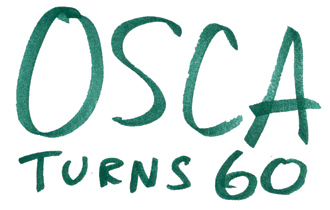
For six decades, Oberlin co-ops have brought democracy—and a lot more—to the dining room.
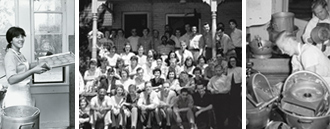 Oberlin co-ops past— including Pyle Inn’s original members (center)
Oberlin co-ops past— including Pyle Inn’s original members (center)
Sixty years ago, when Al McQueen ’52 and 60 other ambitious Oberlin students asked the college administration if they could cook for themselves in an old house on West College Street, they couldn’t have known they’d be setting the stage for what generations of future students would claim as their most formative college experience.
Yet for six decades, Oberlin’s largest student organization, the Oberlin Student Cooperative Association (OSCA), has been just that. The housing and dining co-ops run by OSCA—simultaneously dormitories, dining clubs, businesses, political centers, social hubs, and more—have for years served as places for students to hone skills, pursue interests, and explore passions that forever change the course of their lives and work.
"Co-ops touch the lives of a significant percentage of students who come through Oberlin," says Stewart Kohl ’77, a Cleveland businessman who, as a former OSCA president, saw glimpses in OSCA of what a corporate boardroom might be like. "If you were to list the institutions that really make a difference in the lives of students in their years at Oberlin, I think the co-ops would rank pretty darn high."
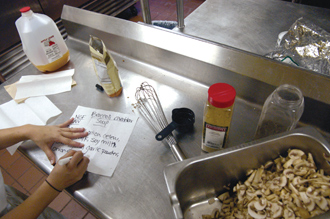 With dietary preferences and food allergies, cooks are careful to let people know what they’re eating.
With dietary preferences and food allergies, cooks are careful to let people know what they’re eating.
Even if co-ops didn’t produce a measurable effect on an Obie’s postgraduate career, they were, for many, an essential part of Oberlin’s culture. They were places where the "labor" part of the college’s motto was revitalized; members, after all, took responsibility for cooking and for cleaning their own houses. They reflected Oberlin’s history of progressive thinking, introducing students to the budding recycling and local foods movements or advocating for an alternative system of decision-making centered on group consensus. And they stood—much like the Parisian salons of the 18th and 19th centuries—simply as places where students congregated to tap into the artistic, social, and political pulse of the college and community.
Today, OSCA operates a cluster of nine individual and idiosyncratic co-ops, housing 175 students and feeding 620. With an annual operating budget of roughly $2.4 million, Oberlin’s is the second largest student cooperative in the country. Members devote four or five hours per week to co-op duties—ranging from cooking to serving on a special committee to managing the organization’s finances—and save $2,810 on college board costs and $1,442 on traditional college housing.
It was this last, essential principle—that vast amounts of money could be saved if students were willing to put in a little work—that first gave rise to Oberlin’s co-ops 60 years ago.
In the late 1940s, in response to what was seen as an expensive college dining plan, many students looked for alternative ways to live and eat. In 1949, inspired by visits to cooperatives at the University of Michigan, Western Reserve University, and Ohio State, a band of students led by Ruth Searles ’51, KiKi Heitkamp ’51, and Grace Thompson ’51 met with a local consumer co-op manager, Bill Long, to better understand cooperative living and gauge the feasibility of establishing their own housing and dining co-op.
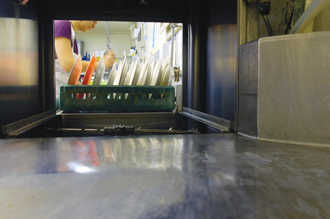 The beloved Hobart dishwasher, familiar to generations of co-opers (this one belongs to Old Barrows).
The beloved Hobart dishwasher, familiar to generations of co-opers (this one belongs to Old Barrows).
Aside from this desire to save money, students also sought an ideological alternative to Oberlin’s restrictive in loco parentis community model—one that called for strict housemothers, geographical and social segregation of men and women, curfews, and dress codes. Such a status quo was under fire, particularly from men in their late 20s who had returned from World War II.
"It was the G.I. Bill, having war veterans at Oberlin, that really allowed the co-ops to happen," says McQueen, an original member of the first co-op. "These men had just returned from fighting for the country and became leaders in the push to getting the administration to stop treating students like kids."
In the spring of 1950, a petition for the establishment of a housing and dining cooperative reached the General Faculty, who accepted it despite concerns by President William Stevenson and the dean of women about students’ ability to take responsibility for a house and maintain social etiquette. Provisional approval was given for student control of Pyle Inn, a large building on West College Street that would house 28 female residents and 28 male boarders. That fall, Pyle Inn served its first meal.
"It was an idealistic year, an experiment; we were making a case," says McQueen, who admits that the project’s success required some tentative steps and a lot of feeling out. "There were interminable house meetings that first year in which everyone spoke his mind on any issue: food, money management, or failure to do jobs—a constant from the first."
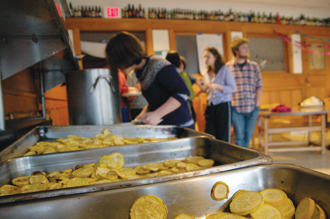 Tankers line up for lunch.
Tankers line up for lunch.
When a second co-op, Grey Gables, opened in 1952, the college kept a watchful eye on the social environment that the new movement had created. Every co-op student had to give evidence of "sound scholastic standing," "emotional stability," and—in the era of McCarthyism—"patriotism." Routine co-op checks were common and sometimes found evidence of abuse of the college’s social laws. Official charges levied at the co-ops in 1952 included dress code infractions, instances of necking in corridors, and even etiquette breaches.
As early as 1952, savings of more than 50 percent over college board bills were reported. Despite a growing wait list and increasing demand for a third co-op, college administrators weren’t eager to act. Not until June 1962, when the co-ops’ student leadership reorganized as the Oberlin Student Cooperative Association and filed for incorporation as a tax-exempt nonprofit institution—complete with bylaws and a board of directors—did the college’s opinion of the movement began to shift.
Early in spring 1963, Oberlin’s Board of Trustees asked sociology professor Kiyoshi Ikeda, one of OSCA’s elected faculty board members, to evaluate the new organization, its membership, and its future. Ikeda’s report revealed that the co-op system was not a hotbed of depraved behavior, nor was it a communist bastion; instead, OSCA was a well-run set of group houses that functioned smoothly, to be viewed not as a liability to the college, but an asset—a staple of Oberlin’s unique culture.
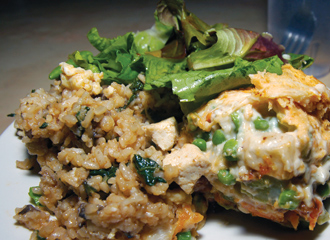 Veggie pot pie and salad at Old B.
Veggie pot pie and salad at Old B.
With the college’s relationship with the burgeoning co-op system dramatically improved, OSCA underwent a period of rapid expansion. Tank replaced Grey Gables in 1963; Keep became the long-awaited third co-op in 1965; and Harkness was approved in 1967. In the early 1970s the co-ops became coed, and Old Barrows opened as an all-women’s house. The original Pyle Inn was torn down in 1973, but in its place came the dining-only co-op Baldwin, followed in 1977 by Fairchild.
That same year, OSCA joined the North American Students of Cooperation (NASCO)—a coalition of college housing cooperatives with which Oberlin had interacted on and off since its inception—and in 1978 joined the Federation of Ohio River Co-ops (FORC), a co-op food warehouse that introduced Oberlin to both a distinctive variety of tortilla chips and to the now-ubiquitous consensus-based decision-making process, the goal of which is to resolve an issue with as much agreement as possible.
"Consensus-centered discussions could be time-consuming and even frustrating," says Andrew Stoloff ’83, who lived in Harkness. "But I came to understand the value of those types of discussions—that I have as much to learn from people as they do from me. Saying that something works for me, so that’s the way we’re going to do it—that’s never been an option for me since Oberlin."
OSCA continued to grow in the 1980s with the purchase of two off-campus rental properties—Fuller in 1985 and Bliss in 1987. But an audit by the IRS in 1987 and a subsequent bankruptcy scare proved the fragility of an organization whose membership and leadership changed each year. Though it had historically been run solely by students, OSCA soon voted to hire a permanent staff member (Iris Hunt, who has been at the job ever since) to alleviate the stress of tracking finances and to create some much-needed institutional memory.
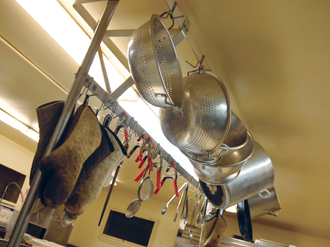 Old B’s industrial strength kitchen.
Old B’s industrial strength kitchen.
OSCA also faced down some of the issues over inclusiveness that had long been a challenge for the co-ops. In 1987, it integrated an existing co-op that served solely Kosher food, and in 1993 created the Third World Co-op dedicated to serving people of color and low-income students and to those interested in Third World issues. Accessibility became a topical issue, and OSCA’s leadership hashed out new policies to allow people from all types of backgrounds to join the co-op community.
"At the time, Harkness didn’t have a handicap ramp. But that was a physical manifestation of the need for accessibility—financial accessibility was just as important," says Andy Waxman ’93, a former OSCA president who now runs a Boston-based community development organization. "Even though OSCA cost less than dining services, we needed to find ways to make it more accessible. For example, we had some co-op students putting in hours and hours of work study, and some students not doing any—so there needed to be flexibility in time spent completing jobs in the co-op."
Eventually, OSCA’s social action spread beyond the institution itself. In an effort to support cooperatives and other businesses, OSCA began to offer loans to burgeoning organizations nearby—such as Oberlin’s Bike Co-op and Contraceptive Co-op—and far away, such as the Wisconsin Women’s Business Initiative and the Cooperative Fund of New England.

And for nearly two decades, OSCA has been partnering with Nicaragua’s National Union of Farmers and Ranchers, sending between $2,000 and $5,000 annually to support a micro-loan fund for female farmers in the drought-stricken region of San Juan de Limay. In addition, OSCA sends a small delegation to Nicaragua during winter term to live with the women. Alice Ollstein ’10, a former coordinator of the delegation, says the co-ops and the Nicaraguan union share the same core values: "A belief that nutritious and plentiful food, clean water, a dignified living space, accessible education, and a healthy environment are rights—not commodities; and a dedication to promoting equality of gender and race, democratic decision-making, and local and international cooperation."
In more recent years, OSCA has seen growth and prosperity (a new Pyle Inn based in Asia House kitchen opened in 1995, and the Brown Bag Co-op, a grocery store located in Fairchild’s basement, became a part of OSCA in 2004), as well as endured hardships, such as the sale of its rental properties.
As long as OSCA exists, bread makers will bake, discussion leaders will facilitate discussion, and the co-ops will influence the lives of generations of Oberlin students in both subtle and distinct ways.
"The best thing about OSCA was that every so often—and it wasn’t every night, but frequently enough to be wonderful—every so often, everyone would just nail it. Things would just be perfect," recalls Kohl. It might be a meal, a visit from a professor, a lively discussion, or a great party "that reminded you of why you loved the co-ops and why they were one of the best things about Oberlin."
Michael Emerson Dirda is a writer living in the Washington, D.C. area.
Chaw Chang ’95
Owner, Stick and Stone Farm
Ithaca, New York
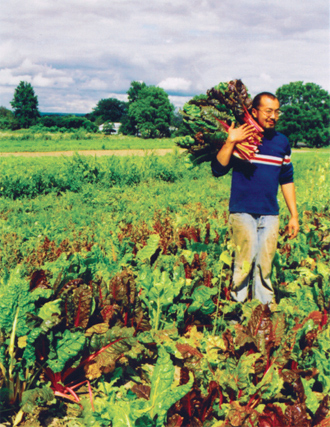
Chaw Chang ’95 wasn’t certain that he would become a farmer, but he couldn’t deny his love for sowing and growing.
From his earliest experiences in Harkness and Old Barrows, Chang was drawn to co-op jobs such as local foods coordinator, local foods buyer, and composter. By the end of his sophomore year, he had set up a community garden behind Johnson House. And during his last semester at Oberlin, he laid the groundwork for a full-fledged college- and community-run agricultural operation—one that would eventually blossom into the farm project at Oberlin’s George Jones Farm.
"At that age, farming, gardening, and cooking your own food—from scratch to finish instead of having it done for you—is amazing and empowering," Chang says.
Today, along with his wife and two children, he runs the 50-acre Stick and Stone Farm in Ithaca, New York. The farm operates under the Community Supported Agriculture (CSA) concept, in which local patrons buy shares of a harvest that are picked up each week during the growing seasons.
"At OSCA, I could see this huge number of people eating things like local eggs," says Chang. "I saw all this product coming in to what was in reality a small community. Seeing those people as a buying group made me realize there was more to successful farming than going to farmers’ markets. It gave me a certain boldness about finding people interested in buying my product, in being creative about selling, and about networking with others."
Chang’s business is part of a three-farm CSA that offers shares of summer and winter crops and sells wholesale to grocery stores and restaurants, to a gourmet foods distributor, and at a local farmer’s market.
"What separates us from a lot of other farms are our networks with other businesses and farmers, and readily engaging them," he says. "There’s no question that’s why we’ve grown the way we have. What OSCA taught me was how to work with those other groups. To interact successfully with people, you have to empathize with their point of view and see how something will work for them. In my opinion, that’s as important as how something will work for me."
Claire Fitts ’02
Owner, Butterfly Bakery of Vermont
Montpelier, Vermont

Claire Fitts ’02 doesn’t remember the actual dinner served at her last special meal at Fairchild Co-op, but she certainly remembers the desserts she whipped up for the occasion.
"We called it ‘Intoxication by Food,’" says Fitts. "I made a white coffee pudding, a spicy chocolate ganache, truffles, and chocolate-covered strawberries. Oh, and of course we had chocolate cake with chocolate frosting and cacao nibs.
"We had so many people at that meal," she adds, recalling the stream of new mouths as co-opers migrated from nearby Harkness when they heard that the Claire Fitts was in charge of dessert. The story’s kicker: None of the dishes Fitts prepared for that meal—or any others at college—contained sugar. Fitts, whose hypoglycemia bars her from eating refined sugar, hasn’t cooked with the stuff since she was 14. She fit right in at Fairchild, historically OSCA’s most health-conscious co-op, whose members at the time opted not to use sugar cane products.
For Fitts, experiences such as her legendary special meal proved there was a consumer market for alternative sweets, and not just for those with restricted diets. As her graduation approached, Fitts, a computer science major who saw the dot-com bubble burst, realized her passion might actually be a viable career option.
"I had a moment of not knowing what to do, before realizing that I might be able to turn my fun hobby into a career," she says.
Fitts spent four years in Fairchild as a dessert and bread maker. She also taught a dessert class in Oberlin’s Experimental College, baked at the now-defunct Kotok’s restaurant, and spent a few years working at a co-op grocery store before taking the plunge and opening her own bakery and catering company in Vermont. Today, she ships her cookies, scones, spreads, and truffles—all sweetened with maple syrup, organic raw agave nectar, or malted barley and corn—throughout the country.
Has turning a favorite pastime into a job proven to be a worthwhile life choice?
"If someone who is not a morning person is excited to be at work at 5 a.m. every single day," Fitts says, "I think they’ve found pretty good job."
Stewart Kohl ’77
Co-CEO, The Riverside Company
Cleveland, Ohio

"OSCA was a little business—and maybe not so little, if you think about the ambition of feeding and housing so many students," says Cleveland businessman Stewart Kohl ’77, co-CEO (with Bela Szigethy ’77) of private equity firm The Riverside Company. "And though of course I didn’t do it by myself at all, it was the first business I ran."
The OSCA of the late 1970s functioned without professional assistance; it wasn’t until 1990 that the organization hired its first full-time financial manager. Kohl’s presidency had him overseeing day-to-day tasks, such as the billing of OSCA members, as well as evaluating the purpose, goals, and direction of the organization.
"I would liken the OSCA presidency to a full-time job," he says. "I made a conscious decision my senior year, that instead of pursuing honors in government or economics and starting down the track that would have led to an advanced degree, to put my time and energy into the co-ops. Like running any business, there was a lot of administration to be done and many lessons to be learned." Kohl focused on strengthening OSCA internally, computerizing its records, and reengaging with the North American Students of Cooperation (NASCO) to bring Oberlin into the greater student cooperative movement.
Following his graduation in 1977, Kohl remained devoted to the movement, spending three years as executive director of NASCO—where he taught and trained new co-opers and lobbied to create a national consumer cooperative bank that would finance new co-ops—and seven years with the National Cooperative Business Association, eventually becoming executive vice president. He later entered the world of finance with an appointment at Citicorp Venture Capital, the private equity arm of Citibank, before joining The Riverside Company in 1993.
Though the OSCA presidency had certainly equipped him with the tools for preparing financial reports, Kohl was most affected by realizing the true power of a group of like-minded people working strategically toward a goal.
"It was seeing what you could achieve together that you couldn’t have achieved alone that made the co-op such a special place," he says. "How to collaborate with others in groups and teams—which is inherent at OSCA whether in cooking dinner or being president—that was an essential life lesson and business lesson."
Believing in the power of partnership has served Kohl well. To date, The Riverside Company’s investments in 231 companies around the world have allowed the firm to build more than $3 billion in assets under management.
Who needs that advanced degree, anyway?
Trevett ’98 and
Sarah Curtis Hooper ’99
Co-owners, Legume Bistro
Pittsburgh, Pennsylvania
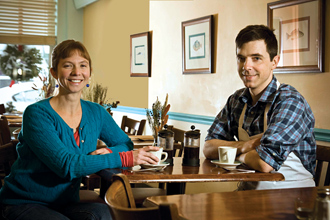
"When an OSCA kitchen is running effectively, it’s a beautiful thing. When people can put aside their egos and work together, it can be beautiful to see everyone and everything coming together," says Sarah Curtis Hooper ’99, who—with her husband, chef Trevett Hooper ’98—runs Legume, a top-rated Pittsburgh bistro. "The same thing is true in a restaurant: When everyone is on the right track, it is a beautiful thing to watch it function. That’s something we first got to see at Oberlin."
You won’t find many OSCA-inspired dishes on the menu at Legume (though Trevett does admit to cooking with more whole grains and beans than his peer institutions, and that his restaurant is—like the co-ops—"very vegetable-centered"). Nevertheless, the restaurant has the markings of OSCA all over it. For starters is the sense of equality and democratic participation that takes place in their restaurant. The Hoopers shy away from what they consider a hierarchical "corporate" structure—"the chef’s way or highway." Instead, they believe that any one person can contribute to the success of a dish, a relationship with a customer, or the growth of the restaurant as a whole.
"Everyone has an opinion about food, everybody has things they like, and everybody has something to offer in terms of a vision or experiences," says Trevett. "Even if a cook has been working with me for six months, that person has had experiences or has eaten places or has learned things cooking with their family that could be of value to our restaurant.
"Of course, I’m still the boss, and it’s Sarah’s and my house that goes to the bank if we’re not successful," he jokes. "But we’re more attuned to hearing other people’s opinions and ideas than a lot of restaurants are."
Trevett and Sarah’s OSCA experience also made them realize that food is more than what’s on the plate. Long discussions about the ethics of food production—like ones Sarah had at Harkness about the human suffering involved in farming and processing bananas—made the couple aware that their purchasing decisions have much broader implications.
"My period in OSCA was the first time I was thought about where my food comes from," says Trevett.
"In a way, understanding how food works in this country is to our disadvantage. I absolutely can’t let myself buy cheaper factory farmed beef or factory farmed pork, yet I’m competing with restaurants that do," he adds. "Maybe ignorance is bliss; maybe we could be making a lot more money if we didn’t learn the things we learned. But then we wouldn’t have this beautiful community of people who care about what they eat."
"It was an idealistic year; an experiment; we were making a case."
Third World Co-op Brings Accessibility and Diversity to OSCA — and New Flavors
OSCA was founded on the principles of voluntary and open membership without discrimination by race, sexual orientation, religious or political belief, or social position. For much of its history, though, OSCA struggled with achieving the diversity it proclaimed. It was, as Third World Co-op founder Little Wing Lee ’95 describes it, "hippy and white."
"I was surprised that more people of color weren’t part of the co-ops," says Lee. "I was on financial aid at Oberlin, and I thought that any way I could save money and stop my mom from taking out more loans was a good thing. OSCA also seemed to support things I’d grown up with: community, eating with family and friends, having everyone contribute to the meal. And with a lot of disparities in healthcare and access to food in communities of color, it was interesting that those communities wouldn’t be part of OSCA, which was a way to eat healthier."
When the existing but independent Kosher Co-op was added to OSCA’s ranks in 1987, the interest in accessibility and diversity grew. Foremost among new initiatives came a push to establish a co-op that would be a safe space primarily for students of color and first-generation students. In 1989, 200 people of color signed a petition for the establishment of a permanent "Third World Co-op," but OSCA, too financially troubled at the time, could not devote resources to the cause.
A report by Oberlin’s Student Organization Against Racism at the end of the decade found that just 17 of the 547 members of OSCA—an alarmingly low 3 percent of the membership body—were students of color. Such low membership was troubling to students like Lee, who felt that the co-op system could serve minority and first generation students incredibly well—if only they’d give it a chance.
The push for a Third World Co-op grew stronger in the early 1990s. At both individual houses and at the OSCA board level, discussions about the new co-op—whether it should exist, what its mission should be, and even what it should be called—became hot topics. When the issues were finally put to an all-OSCA vote, Third World Co-op—defined by members’ engagement and interest in Third World issues, not necessarily by skin color or background—was approved and opened in Baldwin in the fall of 1993.
"Most of the members of the co-op in the first year had never been members of OSCA before, so in that way it was a big success," recalls Lee. "Everybody said that Third World Coop had the best food, too. The place was about diversity, but it was also about diversity of types of food. Our special meals really tried to express the membership of our co-op; if we had someone whose parents were Nigerian, he or she might have done a Nigerian dinner.
"I also felt that we had a very strong community, and that the members of the co-op were very active both as members of OSCA and the larger diverse community in Oberlin," Lee continues. "It was great for coalition building, and people made a more conscious effort to be responsible to each other. There was a real sense that we had to work together to make it successful."
Today, the co-op feeds 30 students, and its members comprise leaders and members of nearly every minority groups on campus.
What are Co-ops?
Co-ops, in their most basic form, are businesses owned and controlled equally by the very people who use their services. Oberlin’s co-ops, along with consumer, business, housing, and dining co-ops of all kinds around the world, operate with respect to a set of ideals known as the Rochdale Principles. Put forth in 1844 by the Rochdale Society of Equitable Pioneers, a group of English artisans, these seven laws set co-ops apart from other businesses in their commitment to open and voluntary membership, democratic control, limited returns on capital, non-profit operation, ongoing education of members, support of like-minded co-operatives, and service to the community.
The Rochdale Principles
Set forth by the Rochdale Society of Equitable Pioneers, an early consumer cooperative in England in the 19th century, the Rochdale Principles form the philosophical framework upon which Oberlin’s coop system rests. The Principles are:
- Voluntary and open membership
- Democratically run: One student=one vote. Since 1979, consensus voting—ensuring that everyone in each coop agrees with each decision—has been prevalent in coops
- Non-profit and equal distribution of economic savings
- Education of principles
- Cooperation among cooperatives
- Political non-partisanship
- Concern for community
Recipes
Savory Sweet Potato Home Fries
Most beloved of all the large, starchy, tuberous root vegetables, the sweet potato grows late into the season and keeps well, and as a result appears on the co-op menu nearly year-round. Great to fill up on before donning a pirate costume and blowing all that energy jousting at Harkness’ annual bike derby.
Ingredients:
- 5 sweet potatoes, peeled and chopped into cubes
- 1 onion, chopped
- 4 cloves garlic, minced
- Olive oil
- black pepper, thyme, rosemary, oregano
- dash of salt
Instructions:
Sauté the onion and garlic in olive oil in large saucepan until partially cooked. Add in sweet potatoes and seasonings—start with a teaspoon of each (except salt) and increase as needed—and mix thoroughly. Once all ingredients are mixed, place sweet potatoes on baking pan, cover with aluminum foil, and bake at 350 degrees until potatoes have cooked through. Feeds six.
Recipe courtesy of Epiphany Acevedo ’11
Maple Granola
Any set of co-op recipes wouldn’t be complete without this perennial OSCA favorite. For an authentic co-op experience, invite over everyone you know, make the recipe times six, and serve with gobs of yogurt.
Ingredients:
- 10 cups rolled oats
- 1 teaspoon cinnamon
- 1 cup maple syrup
- ¾ cup water
- ¼ cup canola oil
- ½ teaspoon salt
- ½ cup flax meal
Instructions:
Preheat oven to 300 degrees. Combine oats and cinnamon in a large bowl. Combine maple syrup, canola oil, salt, and flax meal in saucepan. Heat until just warm, and stir into oat mixture. Spread mixture out on two baking sheets and bake at 300 degrees for 30 minutes. Remove from oven, stir and break up clumps, then bake for an additional 20 minutes. Add nuts, raisins, cranberries, or dry fruit as desired. This recipe will make one large batch.
Courtesy of Lisa Goddard ’11
Crispy Kale
Kale: It’s not just for rabbits anymore. When roasted, this type of cabbage develops a crispy crunch, making it a perfect, healthy substitute for french fries or chips. Great as a side dish at dinner, or as a snacking item alongside a rousing game of Settlers of Catan in the lounge at Old Barrows.
Ingredients:
- fresh kale
- garlic
- olive oil
- Parmesan Cheese (optional)
Instructions:
Cut kale into bite-sized pieces and coat with olive oil and minced garlic. Place on a cookie tray and bake at 350 degrees for about 15-20 minutes. Sprinkle Parmesan cheese on top if desired.
Recipe courtesy of Jessica Cummings ’10
